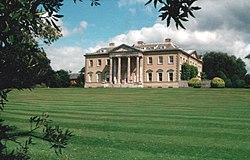Broadlands
| Broadlands | |
| Hampshire | |
|---|---|
 Broadlands, c. 2008 | |
| Location | |
| Grid reference: | SU35392024 |
| Location: | 50°58’50"N, 1°29’50"W |
| Village: | Romsey |
| History | |
| Built 1767 | |
| By: | Henry Holland |
| Country house | |
| Information | |
| Owned by: | The Earl Mountbatten of Burma |
Broadlands is a country house standing by the River Test in Hampshire, close by of Romsey, and which is the home of the Earl Mountbatten.
The house is a Grade I listed building.[1] The formal gardens and historic landscape of Broadlands are Grade II* listed on the Register of Historic Parks and Gardens.[2]
History
The original manor and area known as Broadlands belonged to Romsey Abbey since before the Norman Conquest.
In 1547, after the Dissolution of the Monasteries, Broadlands was sold to Sir Francis Fleming. His granddaughter married Edward St Barbe, and the manor remained the property of the St Barbe family for the next 117 years. Sir John St Barbe, 1st Baronet (c. 1655–1723) made many improvements to the property but died without children, bequeathing his estate to his cousin Humphrey Sydenham of Combe, Dulverton.
Having been ruined by the 18th-century South Sea Bubble, in 1736 Sydenham proceeded to sell Broadlands, with its Tudor and Jacobean manor house, to Henry Temple, 1st Viscount Palmerston, for £26,500. It was the latter who began the deformalisation of the gardens between the river and the house and produced the broad-lands, a "gentle descent to the river".
In 1767, a major architectural "transformation" of the house and garden was begun by Capability Brown, the celebrated architect and landscape designer, and completed by the architect Henry Holland, which led to making Broadlands the Palladian-style country house seen today. Henry Temple, 2nd Viscount Palmerston, had requested that Brown go there and seize upon the "capabilities" of the earlier manor house. Between 1767 and 1780, William Kent's earlier "deformalising work" was completed, as well as further landscaping, planting, clearing and riverside work.
Broadlands was the country estate of the 19th-century British prime minister Henry John Temple, 3rd Viscount Palmerston.[3] After his death, the estate was inherited by his step-son, William Cowper-Temple, 1st Baron Mount Temple (1811–1888). A devout Christian, he held public prayer meetings in the grounds. On his death, the estate passed to a great-nephew, Evelyn Ashley (1836-1907), a younger son of Anthony Ashley-Cooper, 7th Earl of Shaftesbury (1801-1885).[4] Subsequently Broadlands passed to Evelyn Ashley‘s son Wilfrid Ashley, 1st Baron Mount Temple, who died in 1939 and left it to his daughter Edwina Ashley, the wife of Lord Louis Mountbatten.
Queen Elizabeth II (then Princess Elizabeth) and Prince Philip spent their honeymoon at Broadlands in November 1947; the first Earl Mountbatten of Burma, whose home Broadlands was at the time, was Philip's uncle.[5] In 1981, the newly-married Prince and Princess of Wales also spent the first three days of their honeymoon at Broadlands, travelling to the estate by train from London Waterloo.[6]
The house today
Broadlands is the home of the Earl and Countess Mountbatten of Burma. The house is opened to the public for guided tours on weekday afternoons in summer.[7]
References
- ↑ National Heritage List 1166489: Broadlands House (Grade I listing)
- ↑ National Heritage List 1000166: Broadlands
- ↑ Mee, Arthur (1967). Long, E T. ed. The King's England, Hampshire with the Isle of Wight. London: Hodder & Stoughton. pp. 200–201. ISBN 0-340-00083-X.
- ↑ Broadlands, lordmountbattenofburma.com
- ↑ "Queen releases 60 wedding facts". BBC News Online. 18 November 2007. http://news.bbc.co.uk/1/hi/7100282.stm.
- ↑ Downie Jr., Leonard (30 July 1981). "Britain Celebrates, Charles Takes a Bride". The Washington Post. https://www.washingtonpost.com/wp-srv/inatl/longterm/diana/background/wedding1.htm.
- ↑ "Visitors to Broadlands". https://broadlandsestates.co.uk/visitors-to-broadlands/. Retrieved 11 September 2018.
- Turner, Roger: 'Capability Brown and the Eighteenth Century English Landscape' 2nd Ed. (Phillimore, 1999). pp. 108–110. ISBN 978-1-86077-114-9.
Outside links
| ("Wikimedia Commons" has material about Broadlands) |